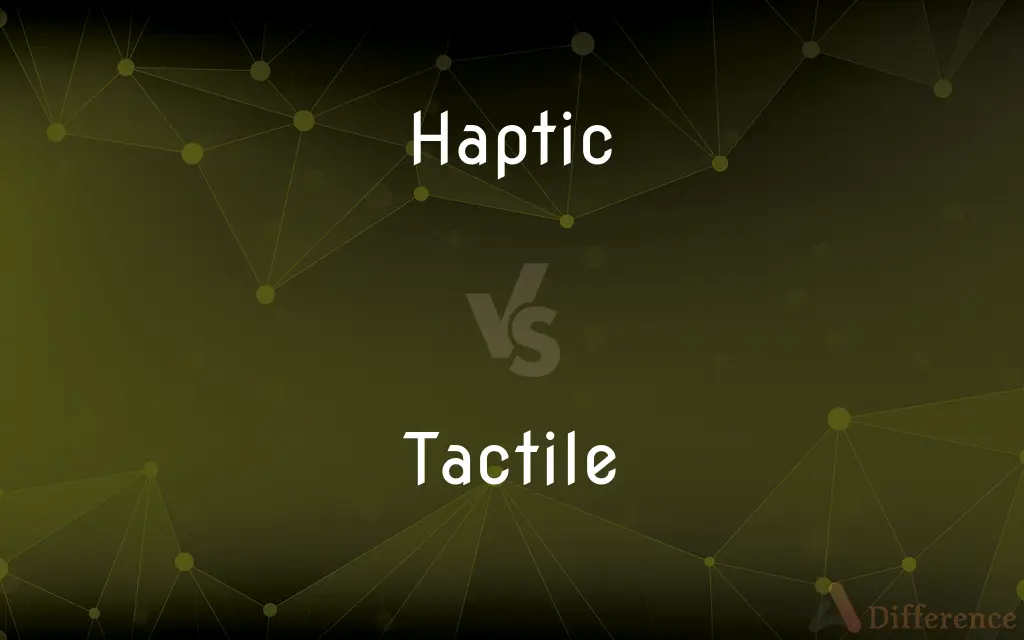Haptic vs. Tactile — What's the Difference?
Edited by Tayyaba Rehman — By Urooj Arif — Updated on March 13, 2024
Haptic technology simulates touch through vibrations or motions, enhancing digital interactions, while tactile refers to the physical sensation of touch itself.

Difference Between Haptic and Tactile
Table of Contents
ADVERTISEMENT
Key Differences
Haptic technology involves creating experiences that simulate the sense of touch through vibrations, forces, or motions, making digital interactions more immersive. On the other hand, tactile sensation is the physical feeling of touch, which enables individuals to perceive textures, temperatures, and shapes through skin contact.
While haptic feedback is often engineered into devices to mimic real-world touch sensations, enhancing user interfaces and experiences, tactile sensations are natural perceptions processed by the nervous system, providing essential information about the environment. Haptic technologies aim to bridge the gap between digital and physical by replicating tactile sensations, thereby enriching user experiences in virtual or remote settings.
The development of haptic technology requires a multidisciplinary approach, incorporating elements of mechanical engineering, computer science, and psychology to simulate tactile sensations effectively. Conversely, understanding tactile sensations involves biological and physiological studies, focusing on how sensory receptors in the skin relay information to the brain.
Haptic feedback systems can be designed to produce a wide range of sensations, from the replication of a gentle breeze to the mimicry of holding an object, broadening the scope of digital interaction. Tactile sensations, however, are limited to the capabilities of human sensory receptors and the natural range of experiences they can detect.
In practical applications, haptic technology is utilized in various fields, including virtual reality, gaming, and medical training, to create a sense of realism and immersion. Tactile sensation, by contrast, plays a crucial role in everyday tasks, from manipulating objects to navigating environments, underpinning human interaction with the physical world.
ADVERTISEMENT
Comparison Chart
Definition
Technology that simulates touch through mechanical vibrations or forces.
The physical sense of touch perceived through skin contact.
Purpose
To enhance digital interactions by simulating touch sensations.
To perceive physical properties like texture, temperature, and shape.
Implementation
Requires electronic devices and software programming.
Natural ability processed by the human nervous system.
Scope
Can create a broad range of simulated touch sensations.
Limited to the natural capabilities of human touch.
Applications
Used in virtual reality, gaming, robotics, and medical simulations.
Fundamental to everyday physical interactions and sensory experiences.
Compare with Definitions
Haptic
The use of mechanical systems to deliver touch-based feedback.
A haptic steering wheel vibrates to alert drivers of lane departure.
Tactile
Fundamental to physical exploration and learning.
Children use tactile sensation to learn about the world around them.
Haptic
Technology that simulates touch sensation through electronic devices.
The smartphone's haptic feedback vibrates to mimic a button press.
Tactile
The physical feeling of touch through skin contact.
The tactile sensation of silk is smooth and soft.
Haptic
A method to create immersive virtual experiences by simulating touch.
Haptic gloves in VR simulate the sensation of touching virtual objects.
Tactile
Essential for everyday tasks and interactions.
Tactile feedback aids in typing accurately on a keyboard.
Haptic
Integrating touch sensations into user experiences for realism.
Haptic suits in gaming make players feel environmental effects like wind.
Tactile
The human body's natural response to environmental stimuli.
Tactile sensation alerts us to a sharp object's danger.
Haptic
Enhancing digital interfaces with physical sensations.
Haptic feedback on a touchscreen provides a sense of pressing physical buttons.
Tactile
Sensing physical properties like texture and temperature.
Tactile sensations help distinguish between ice and water.
Haptic
Of or relating to the sense of touch; tactile.
Tactile
Relating to, involving, or perceptible to the sense of touch
Tactile sensations.
Tactile sensitivity.
Haptic
Of or relating to the sense of touch.
Tactile
Characterized by or conveying an illusion of tangibility
Tactile language.
Haptic
(computing) Of or relating to the study of user interfaces that use the sense of touch.
Tactile
Tangible; perceptible to the sense of touch.
Haptic
Relating to or based on the sense of touch.
Tactile
Used for feeling.
Haptic
Of or relating to or proceeding from the sense of touch;
Haptic data
A tactile reflex
Tactile
Of or relating to the sense of touch.
Tactile
Of or pertaining to the organs, or the sense, of touch; perceiving, or perceptible, by the touch; capable of being touched; as, tactile corpuscles; tactile sensations.
The delicacy of the tactile sense varies on different parts of the skin; it is geatest on the forehead, temples and back of the forearm.
Tactile
Of or relating to or proceeding from the sense of touch;
Haptic data
A tactile reflex
Tactile
Producing a sensation of touch;
Tactile qualities
The tactual luxury of stroking silky human hair
Common Curiosities
What is tactile sensation?
Tactile sensation is the physical sense of touch, enabling individuals to perceive textures, temperatures, and shapes through skin contact.
In what applications is haptic technology used?
It's used in virtual reality, gaming, robotics, and medical simulations to simulate touch sensations for a more immersive experience.
How does haptic feedback enhance user experience?
It provides physical feedback in digital interactions, making them more engaging and realistic.
Can haptic technology improve learning or training?
Yes, it can enhance learning in virtual environments by simulating realistic touch interactions, beneficial in fields like surgery or rehabilitation.
Can the absence of tactile sensation affect individuals?
Yes, conditions that impair tactile sensation can affect daily activities, safety, and the ability to perceive the environment fully.
How do haptic technology and tactile sensation differ?
Haptic technology creates artificial touch sensations in digital environments, while tactile sensation is the natural feeling of touch perceived by humans.
Is tactile sensation only related to the hands?
No, tactile sensation can be experienced by any part of the skin, providing sensory information from all over the body.
What are the components of a haptic system?
A haptic system typically includes actuators to generate touch sensations, sensors, and software to control the feedback.
What role does tactile sensation play in communication?
It can convey emotions or information through touch, such as comfort through a hug or caution through a grab.
What is haptic technology?
Haptic technology simulates touch sensations through mechanical means like vibrations or forces, enhancing digital interactions.
Why is tactile sensation important?
It's essential for perceiving environmental properties, navigating surroundings, and performing everyday tasks.
Can haptic technology replicate all tactile sensations?
While it can simulate a wide range of sensations, it may not fully replicate the complexity of natural tactile experiences.
How is haptic feedback implemented in mobile devices?
Through vibration motors or piezoelectric actuators that simulate touch sensations like clicks or bumps.
What advancements are expected in haptic technology?
Future advancements may include more refined simulations of complex textures and temperatures for even more realistic digital touch experiences.
How do humans perceive tactile sensations?
Sensory receptors in the skin send signals to the brain, which interprets them as various tactile experiences.
Share Your Discovery

Previous Comparison
Adversity vs. Setback
Next Comparison
Ammolite vs. AmmoniteAuthor Spotlight
Written by
Urooj ArifUrooj is a skilled content writer at Ask Difference, known for her exceptional ability to simplify complex topics into engaging and informative content. With a passion for research and a flair for clear, concise writing, she consistently delivers articles that resonate with our diverse audience.
Edited by
Tayyaba RehmanTayyaba Rehman is a distinguished writer, currently serving as a primary contributor to askdifference.com. As a researcher in semantics and etymology, Tayyaba's passion for the complexity of languages and their distinctions has found a perfect home on the platform. Tayyaba delves into the intricacies of language, distinguishing between commonly confused words and phrases, thereby providing clarity for readers worldwide.












































